Top News

April 30, 2017 Ryukyu Shimpo
On the morning of April 29, in front of the gate of Camp Schwab in Henoko, Nago City, a mass rally was held to block construction of new U.S. base. At the rally, participants called for the repeal of the so-called “anti-conspiracy bill” and urged people not to forget the “4.28 Day of Humiliation”.
It became the first large-scale gathering after the Okinawa Defense Bureau began sea wall construction to reclaim sea off the coast of Camp Schwab on April 25.
An executive committee consisting of the Okinawa Peace Movement Center and the prefectural assembly’s ruling parties organized the rally.
According to the organizer, about 3,000 people took part in the rally. The participants raised their voices in protest against construction carried out forcefully by the central government and called for the construction of the new U.S. base in Henoko to be blocked. The new base is part of a project to relocate the U.S. Futenma airfield in Ginowan.
The rally also aimed to raise awareness of the “day of humiliation” when Okinawa was separated from Japan following the enforcement of the San Francisco Peace Treaty on April 28, 1952. It also called for the scrapping of the bill to revise the Act on Punishment of Organized Crimes incorporating “conspiracy crimes”.
The participants prayed for the soul of a victim, an Okinawan woman who was assaulted and murdered by a U.S. military civilian worker (a former U.S. marine) one year ago, on April 28, 2016.
The rally adopted a resolution stating: “The request to relocate the Futenma base ‘outside the country or outside the prefecture’ has been being ignored by the central government. The three powers, legislative, judicial and executive, join together in attacking Okinawa. We will not yield to them.”
Tetsumi Takara, president of the Okinawa Constitution Promotion Council said on behalf of the organizer, “The situation in which Okinawan popular opinion is disregarded is still going on. We want to have the right to self-determination. The excessive concentration of U.S. military bases on Okinawa has been causing incidents and accidents. We would like to strive to block construction of the new base in Henoko, without forgetting the day of humiliation.”
Nago Mayor Susumu Inamine said, “Due to the discriminatory measures by the Japanese government, we are suffering under the heavy pressure of the base. We just want to live a normal life quietly. We will not allow the base to be built in Henoko. We want to do our best to lead to complete revocation [of the Futenma relocation plan].”
Hiroji Yamashiro, director of the Okinawa Peace Movement Center, Diet members from Okinawa and other speakers called for solidarity.
(English translation by T&CT)
Go to Japanese
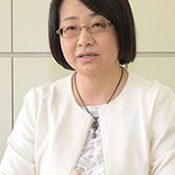
April 28, 2017 Ryukyu Shimpo
We interviewed attorney Naoko Murakami, who represents the family of the deceased in the case of rape and murder of a woman by a U.S. military contractor, which occurred one year ago.
◇ ◇
― How are the family doing now?
“From the perspective of the family, no progress has been made at all. Pretrial arrangement procedures have begun, but there is still no knowing when the trial will start or when a verdict will be made. The case remains unsolved and there has been no compensation. The family feels great loss and their wounds are not healed. They have suffered tremendous psychological damage, making it hard to work, so their income has taken a hit.”
― The defendant has made comments that were hurtful to the family.
“The family is very hurt and very indignant. They asked why he would unilaterally make such proclamations at that timing through the mass media. The two things required to support the family are to properly punish the defendant and to compensate the family and the victim, who have been harmed, in addition to ensuring that they receive emotional care.”
― Has there been any progress in terms of compensation?
“We have no idea what will happen. It is hard to move forward with procedures for compensation without a ruling in a criminal trial. It is also not clear whether the Japanese and U.S. governments would provide compensation pursuant to the Status of Forces Agreement (SOFA) should the defendant be unable to pay. The family has been worried and made an inquiry to the Okinawa Defense Bureau early on, but there has been no response whatsoever.”
― What do you think about the incident turning into a political problem?
“As the family commented at the prefectural people’s rally [last year], they feel that the tragedy was a result of the U.S. bases being in Okinawa. When discussions began about limiting the scope of military-affiliated persons with SOFA status, the family was worried that they might not receive compensation. As their representative, I am encouraged that many Okinawans share the family’s pain. I want people not to forget the incident and to think about why it happened.”
― What are your hopes for reporting on the issue?
“Immediately after the incident, the family was interviewed when they were still very shaken and unable to process their emotions. Reporters went to their home and refused to leave until they got an interview, so they suffered secondary damage as a result. If victims caught up in reporters’ competition to get an interview refuse to speak, information that should be spread will never make it to the public. It is necessary to establish a reporting system and rules that align with the family’s needs. When interviewing the victims, I want reporters to stand in the victims’ shoes.”
(English translation by T&CT and Sandi Aritza)
Go to Japanese
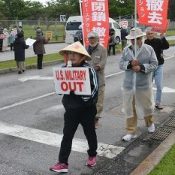
April 28, 2017 Ryukyu Shimpo online edition
On the morning of April 28, the Kadena Peace Action group, which is demanding the closure and removal of Kadena Air Base, held a protest gathering in front of the base’s gates 1 through 5. Participants dedicated a minute a silence to the woman who went missing in Uruma City on April 28, 2016 exactly one year ago, and was later found to have been the victim of assault and murder by a U.S. serviceman.
About 50 people gathered in front of Kadena’s Gate 1 in Chatan Town chanting slogans such as “remove Kadena Air Base,” and “U.S. military, get out of Okinawa.”
Sixty-four-year-old Chieko Teruya of Itoman City tearfully called for the removal of Kadena Air Base. She said: “I, too, have a daughter. At no point this year did I forget about the women who have suffered. As long as there are bases [in Okinawa], incidents like this will occur again and again.”
(English translation by T&CT and Erin Jones)
Go to Japanese
April 28, 2017 by Ryukyu Shimpo
The San Francisco Peace Treaty took effect on April 28, 1952, when Japan gained its independence, and when Okinawa, along with Amami and Ogasawara, were split from Japan.
In Article 3 of the Peace Treaty, the United States, with Japan’s consent and without intervention from any other country, gave themselves the ability to have free use of military bases. The U.S., ignoring the basic human rights of Okinawan citizens came with “bayonets and bulldozers,” taking away farmland and building the largest military bases in all of East Asia. Without a doubt, for Okinawa this is a, “Day of Shame.”
Okinawa recognizes April 28 as the, “Day of Humiliation,” demanding the restoration of their right to self-determination.
Currently, the Abe administration is forcing through new base construction in Henoko, Nago, against the popular will expressed in elections. There should never be a time when Okinawan’s right to self-determination is so blatantly disregarded in modern times. We must learn from the past, and for the sake of the future respond to blatant authoritarianism with unflinching resolve.
Why have the many problems associated with the bases, including incidents, accidents, noise damage, environmental pollution and human-rights violations not been resolved 65 years after the signing of the San Francisco Treaty.
The cause of the base problems stems from the stationing of the American military in Okinawa, and the lopsided Japan-U.S. Status of Forces Agreement (SOFA). Because the Japanese government has not demanded any substantial amendments to SOFA, the base problems go unresolved, and Okinawan citizens continue to be victimized.
Meanwhile, with the exception of Okinawa, U.S. military bases in Japan were reduced significantly up through the latter half of the 1970’s, almost entirely erasing the base problems of the time symbolized by anti-American nationalism. Conversely, the concentration of bases in Okinawa increased.
Looking at the results of a survey of the attitudes of Okinawan residents conducted once every five years by Ryukyu Shimpo (released January 1 of this year), over 35% of participants responded to questions about, “the standing of Okinawa within Japan” by indicating they would like to see an increase in Okinawan authority for things like foreign affairs, domestic politics, and even independence. Meanwhile, answers of “stay the course of a single region (prefecture),” decreased 17.7 points, dropping below the majority to 46.1%.
Since the Abe administration does not treat Okinawa fairly compared to the other prefectures in Japan, the Okinawan people should by all means be demanding an increase in autonomy.
The Japan-U.S. alliance can no longer be built on the humiliation and victimization of Okinawa. We demand that Prime Minister Shinzo Abe change his exclusive devotion to the United States, treat Okinawa as fairly as other regions, and recognize Okinawa’s right to self-determination. Only then can you truly call Japan a sovereign nation.
(English translation by T&CT and Sam Grieb)
Go to Japanese
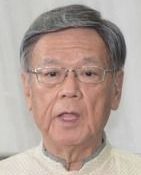
April 26, 2017 Ryukyu Shimpo
The Japanese government began seawall construction off the coast of Henoko, Nago, where it plans to build a new U.S. airfield as a part of the relocation of U.S. Marine Corps Air Station Futenma in Ginowan, on April 25.
Following this move, the Okinawa Prefectural Government (OPG) decided to seek an injunction to block seawall construction as soon as it confirms that the construction has destroyed coral reef on seafloor.
The OPG will file a lawsuit seeking a provisional injunction against the new base construction, and will seek a temporary halt to the seawall construction within one to two months.
Okinawa Governor Takeshi Onaga sternly criticized the central government at a press conference held on the afternoon of April 25 at the prefectural government office. The governor said: “It is unforgivable to forcefully begin [seawall construction] without prior consultation. It is a violent action, ignoring the importance of environmental conservation, as it is likely to kill coral reef ecosystems.”
The governor did not specify when he would withdraw the former governor Hirokazu Nakaima’s approval of the land reclamation.
The governor expressed his concern about the seawall construction, saying, “I feel a great sense of crisis.”
“Although the government is rushing to create a fait accompli, it has not even reached a situation that cannot be reversed again.”
Regarding uneasy feelings spreading through the community, the governor said, “I think the prefectural people are irritated. ”
“I will fight by exercising all my power and taking every measure at the appropriate time to realize the promise made to the citizens not to allow the new base to be built in Henoko,” Onaga said.
Kiichiro Jahana, head of the Executive Office of the Governor, pointed out that if dredging began and steel plates were to be installed, as is expected, within two months, it can be regarded that the work to crush the reef has started without the prefectural government’s permission.
In that case, Jahana said, “We can file a lawsuit without hesitation.”
(English translation by T&CT)
Go to Japanese
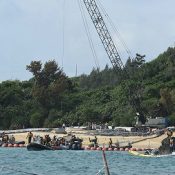
April 25, 2017 Ryukyu Shimpo
On the morning of April 25, the Japanese government began embankment work in Henoko, Nago as the first stage of land reclamation work for Futenma Air Station’s replacement facility. At 9:20 a.m., workers began lowering crushed stones into the water by crane.
The Okinawa Prefectural Government (OPG) is pointing out the Japanese government’s procedural deficiencies, such as failure to consult with the OPG prior to putting concrete blocks under the water for silt curtain installation, or to recognize the importance of applying for the governor’s renewal of the coral fracturing permit. However, even in the face of the OPG and many Okinawans’ opposition to relocating bases within Okinawa, the Japanese government is forcing construction through. Now, 21 years after the 1996 Futenma return agreement, Henoko base construction has entered the land reclamation phase.
Governor of Okinawa Takeshi Onaga has declared that he will exhaust all methods to obstruct construction of the Henoko base. From here, attention is focused on how long it will take Onaga to file the OPG lawsuit to stop construction and to revoke the land reclamation permit.
Piling up crushed stones in the ocean is meant to enclose the area where land reclamation will take place with a levee. As soon as a portion of this levee is complete, land reclamation work will proceed through depositing earth and soil into the ocean. Once a large quantity of stone and soil has been deposited, restoring the ocean to its original state will prove difficult.
As for some background in the matter of Henoko base construction, in December 2013 the then-governor Hirokazu Nakaima approved the land reclamation permit. However, in November 2014 Onaga won Okinawa’s gubernatorial election on the platform of stopping new base construction in Henoko, and in October 2015 canceled his predecessor’s land reclamation permit. The Japanese government brought a lawsuit against the OPG that cancellation of this permit was illegal, and in December 2016 the Supreme Court of Japan decided in favor of the Japanese government in this case.
Photograph description:
On April 25 at 9:20 a.m., laborers begin laying crushed stone for embankment work, the first stage of land reclamation.
(English translation by T&CT and Erin Jones)
Go to Japanese
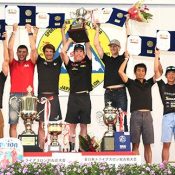
April 25, 2017 Ryukyu Shimpo
Miyakojima – The 33rd All Japan Triathlon Miyakojima (co-hosted by Miakojima City and Ryukyu Shimpo) held its award ceremony April 24 at the JTA Dome Miyakojima. The ceremony featured first time champion Cameron Brown (New Zealand) and women’s race champion Naomi Washizu (formerly Naomi Imaizu, Kanagawa), who won for the third time since 2008. The top ten finishers overall as well as the top three finishers from each age group in the men’s and women’s race were given awards.
Miyakojima Mayor Toshihiko Shimoji, serving as the head of the competition, said, “While I look back at this year’s competition in wonder of everyone’s fighting spirit, I greatly look forward to seeing everyone again at next year’s competition.”
The winners met the applause and cheers of the other athletes with big smiles. At the celebration after the ceremony, athletes interacted with one another, vowing to see each other again at the next competition.
(English translation by T&CT and Sam Grieb)
Go to Japanese
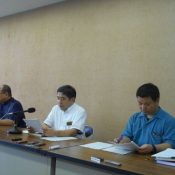
April 21, 2017 Ryukyu Shimpo
The Okinawa Prefectural Government (OPG) announced on April 21 the results of a survey on take-offs and landings of U.S. Marine Corps Air Station Futenma in Ginowan, which was conducted for the first time.
The OPG conducted the investigation at the Futenma base during the period from March 6 to 17. Six MV-22 Osprey aircraft and three CH-53 helicopters moved away from Okinawa for the training. During the period, the number of take-offs and landings of MV-22s decreased from 7.7 times to 5.3 times on average per day. However, the total number of take-offs and landings of all aircraft increased from 43. 8 times to 46.7 times.
The result of the survey showed that transferring training of Osprey aircraft to outside the prefecture had only a limited effect.
The OPG filmed take-off and landing operations with video cameras for two months from February to March and then analyzed the footage.
The total number of take-offs and landings was 2546, with CH-53 helicopters being 770, accounting for 30.2 percent of the total. The MV-22 Osprey aircraft was 447 times, accounting for 17.6 percent of the total number of take-offs and landings of all aircraft.
The number of take-offs and landings during the night after 10:00 p.m. for the period was 31.
The OPG’s official Takekuni Ikeda said: “In order to reduce the burden, it is necessary to transfer training of other aircraft in addition to the Ospreys outside the prefecture. ”
(English translation by T&CT)
Go to Japanese
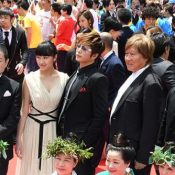
April 24, 2017 Ryukyu Shimpo
The 9th Okinawa International Film Festival came to a close on April 23. The organizer of the film festival set up venues this time in Iheya village, Ishigaki City and other places. A variety of events, including movie screenings, performers and directors’ speeches, talents and comedians ‘ stage performances, were held in various places.
According to the organizer’s announcement, the total number of visitors for four days from April 20 to April 23 was about 330,000 people.
A red carpet event was held on Kokusai Street in Naha on April 23. About 1,000 performers, including actors and comedians, walked around and many crowds cheered them on from the sidewalk.
GACKT, a singer-song writer who is from Okinawa and starred in the movie “Karanukan” filmed in the islands by director Yasuhiro Hamano, said: “This movie has been done well – we were able to pack it tightly with the beauty of Okinawa. I am happy to have participated in the work because I have always wanted to contribute to Okinawa.”
Actress Tao Tsuchiya, Okinawan comedian duo Slim Club and Fashion model Tina Tamashiro walked down the red carpet. Eleven-year-old Ayane Taira said, “I came to see them for the first time. It is fun to see all the various people. Tao Tsuchiya is cute. I like her.”
A closing ceremony took place from 4:30 p.m. on April 23 at Naminoue-umisora Park, Naha.
(English translation by T&CT)
Go to Japanese

April 20, 2017 Ryukyu Shimpo
The very first store of the Sweden-based, globally well-known clothing brand, Hennes & Mauritz, known as H&M, opened in the AEON mall Okinawa Rycom in Kitanakagusuku Village on April 20. More than 1000 people, mostly women, waited for its opening from early morning. Lucas Seifert, CEO of H&M Japan, and Loveli, a model, cut the ribbon to open the store at 11a.m.
The store had some opening gifts for its first customers such as 500 tote bags designed specially for the Okinawa store. Seifert said, “we are happy to be welcomed by so many people in Okinawa. We would like to continue our work as a brand that gives inspiration and surprise to its customers.”
The first H&M in Japan opened in Ginza, Tokyo, in 2008. This opening at the AEON Mall Okinawa Rycom marks the 67th store in the country. The store took over the 1300 square meters on the first and second floor where an American brand, OLD NAVY, used to be the tenant but has left the Japanese market.
(English translation by T&CT and Sayaka Sakuma)
Go to Japanese
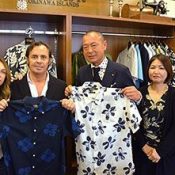
April 21, 2017 Ryukyu Shimpo
Manufacturer of Aloha and Kariyushi shirts JUNE will start selling its brand PAIKAJI this summer in Italy. PAIKAJI was exhibited at Pitti Uomo, the world’s largest clothing fair held in Italy for four years. A select shop president who took part in the fair as a buyer found PAIKAJI and offered the company a contract to distribute their items. In addition to selling the shirts at local stores, they will exhibit them at the company’s showroom located in Milano, aiming to promote the brand in a leading fashion area.
President Josef Montresor, who runs select shop “Studio 92” based in the Padova area in North Italy, has been in Okinawa since the 19th to inspect PAIKAJI’s shops and manufacturing processes. Montresor said, “I would like to let Europe know about a product that is simple yet has Japanese elegance and delicacy with an attractive brand of hybrid Japanese and American cultures. It will be well received in Italy, where people are always on the lookout new fashion.
PAIKAJI started manufacturing in 1999 as an Aloha shirt brand from Okinawa. With the theme of “unusual experience”, PAIKAJI has developed the resort wear design incorporating nature from Okinawa and around the world. Setting up a specialized store along Kokusai dori in Makishi of Naha City, PAIKAJI has promoted the creation of a high value brand while being particular about shapes, materials, and silhouettes.
Sewing has been contracted out to Rio Bianco, a leading garment company based in Fukushima, which is expanding its factory to Okinawa/ expanding its Okinawa factory. Rio Bianco has worked on sewing major domestic brand shirts. President Yoshida says, “The technique of ‘Made in Japan’ supports the sense of openness of Okinawa as a resort.”
In 2013, PAIKAJI was accepted to participate in the men’s wear exhibit “Pitti Uomo” , where 1,200 brands gather from around the world twice a year (January and June) in Firenze.
Montresor, who met the creators of the PAIKAJI brand at the exhibition in June last year said, “The Aloha shirt of American culture is a relaxing cloth. PAIKAJI can be fitted with jackets, and suits and worn as fashion. I am looking for a brand with future potential and growth.”
(English translation by T&CT and Megumi Chibana)
Go to Japaenese










 Webcam(Kokusai Street)
Webcam(Kokusai Street)


